
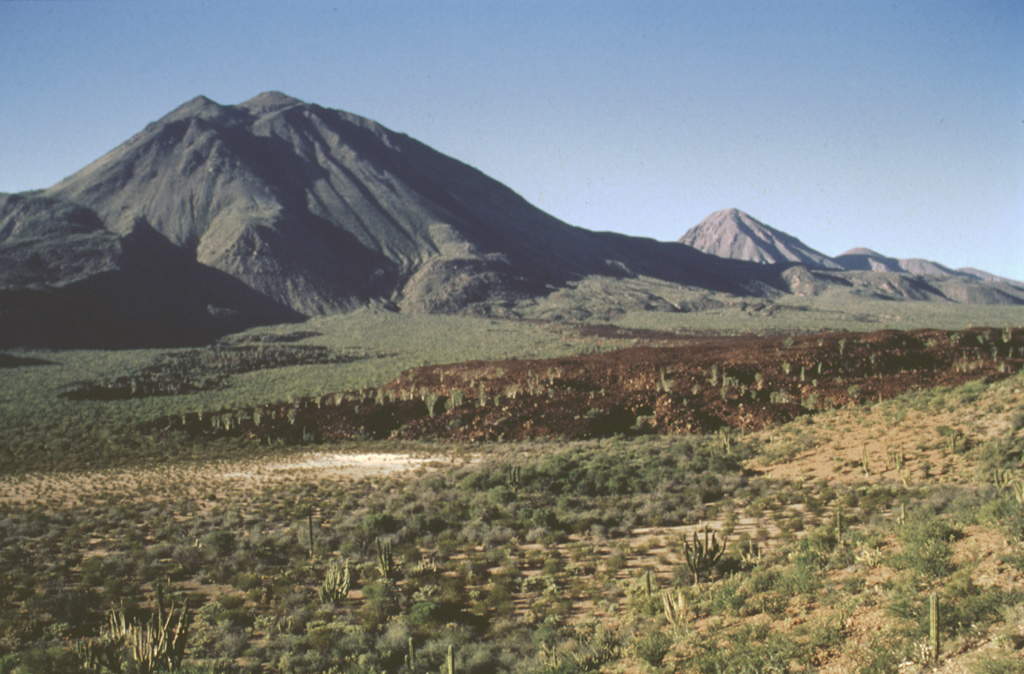
The Global Volcanism Program has no activity reports available for Tres Vírgenes.
The Global Volcanism Program has no Weekly Reports available for Tres Vírgenes.
The Global Volcanism Program has no Bulletin Reports available for Tres Vírgenes.
This compilation of synonyms and subsidiary features may not be comprehensive. Features are organized into four major categories: Cones, Craters, Domes, and Thermal Features. Synonyms of features appear indented below the primary name. In some cases additional feature type, elevation, or location details are provided.
Synonyms |
||||
| Virgenes, Volcán las | ||||
Cones |
||||
| Feature Name | Feature Type | Elevation | Latitude | Longitude |
| Azufre, Volcán el | Stratovolcano | 1650 m | 27° 30' 22" N | 112° 35' 0" W |
| Viejo, El | Stratovolcano | 1333 m | 27° 30' 50" N | 112° 34' 20" W |
| Virgen, La | Stratovolcano | 1934 m | 27° 28' 11" N | 112° 35' 28" W |
Domes |
||||
| Feature Name | Feature Type | Elevation | Latitude | Longitude |
| Mesquital | Dome | 650 m | 27° 26' 7" N | 112° 35' 23" W |
| Pinto | Dome | 1170 m | 27° 27' 18" N | 112° 36' 10" W |
| Virgen | Dome | 1200 m | 22° 27' 8" N | 112° 35' 22" W |
|
|
||||||||||||||||||||||||||
The Global Volcanism Program is not aware of any Holocene eruptions from Tres Vírgenes. If this volcano has had large eruptions (VEI >= 4) prior to 12,000 years ago, information might be found on the Tres Vírgenes page in the LaMEVE (Large Magnitude Explosive Volcanic Eruptions) database, a part of the Volcano Global Risk Identification and Analysis Project (VOGRIPA).
There is no Deformation History data available for Tres Vírgenes.
There is no Emissions History data available for Tres Vírgenes.
 El Azufre volcano (center) is the central peak of the Tres Vírgenes volcanic complex. Its summit lies about 4 km N of the highest peak of the complex, La Vírgen (left). The small peak immediately to the right of El Azufre is El Viejo, the oldest edifice of the complex. El Viejo was constructed SW of the Pleistocene El Aguajito caldera, partly visible on the far-right horizon. Both El Viejo and El Azufre are composed of lava domes and flows.
El Azufre volcano (center) is the central peak of the Tres Vírgenes volcanic complex. Its summit lies about 4 km N of the highest peak of the complex, La Vírgen (left). The small peak immediately to the right of El Azufre is El Viejo, the oldest edifice of the complex. El Viejo was constructed SW of the Pleistocene El Aguajito caldera, partly visible on the far-right horizon. Both El Viejo and El Azufre are composed of lava domes and flows. The two most prominent peaks of the Tres Vírgenes volcanic complex in central Baja California are seen here from the SSW. The peak to the left is El Azufre, a dacite lava dome complex. La Vírgen (right), consisting of andesite lava domes and flank scoria cones, formed more recently and has a more complicated history. It has erupted from both summit and flank vents and has produced both Plinian explosive eruptions and dacitic and andesitic lava flows.
The two most prominent peaks of the Tres Vírgenes volcanic complex in central Baja California are seen here from the SSW. The peak to the left is El Azufre, a dacite lava dome complex. La Vírgen (right), consisting of andesite lava domes and flank scoria cones, formed more recently and has a more complicated history. It has erupted from both summit and flank vents and has produced both Plinian explosive eruptions and dacitic and andesitic lava flows.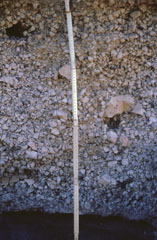 The middle unit of the La Vírgen Plinian fall deposit displays a massive structure (lacking internal structure) with large pink pumice fragments. This deposit, more than 1 km3, is the product of a major explosive eruption that occurred from Tres Vírgenes volcano. The dispersal axis of this airfall deposit was to the SW. The eruption also included the emplacement of pyroclastic flows and voluminous lava flows.
The middle unit of the La Vírgen Plinian fall deposit displays a massive structure (lacking internal structure) with large pink pumice fragments. This deposit, more than 1 km3, is the product of a major explosive eruption that occurred from Tres Vírgenes volcano. The dispersal axis of this airfall deposit was to the SW. The eruption also included the emplacement of pyroclastic flows and voluminous lava flows. This view from the SE shows the Tres Vírgenes volcanic group, which is aligned in a SW-NE direction. Volcanism has migrated to the SW from the oldest peak El Viejo (far right) through El Volcán Azufre to La Vírgen (center), the highest peak. The ridges on the left flank of La Vírgen are rhyodacite lava flows from a major eruption; the smooth hills in the foreground are Quaternary ignimbrite sheets probably related to the Pleistocene La Reforma caldera to the east.
This view from the SE shows the Tres Vírgenes volcanic group, which is aligned in a SW-NE direction. Volcanism has migrated to the SW from the oldest peak El Viejo (far right) through El Volcán Azufre to La Vírgen (center), the highest peak. The ridges on the left flank of La Vírgen are rhyodacite lava flows from a major eruption; the smooth hills in the foreground are Quaternary ignimbrite sheets probably related to the Pleistocene La Reforma caldera to the east.  This view shows the SSW flank of Tres Vírgenes in Baja California. Much of the volcano consists of lava domes and viscous lava flows. The hills on the flanks are rhyodacite lava flows associated with a Plinian eruption. The aligned flat-topped terraces on the plain are underlain by basaltic andesitic lava flows of Tertiary age.
This view shows the SSW flank of Tres Vírgenes in Baja California. Much of the volcano consists of lava domes and viscous lava flows. The hills on the flanks are rhyodacite lava flows associated with a Plinian eruption. The aligned flat-topped terraces on the plain are underlain by basaltic andesitic lava flows of Tertiary age.  The Tres Vírgenes volcanic complex consists of three stratovolcanoes constructed along a NE-SW line, seen here from the SE. La Vírgen (the youngest and highest when this 1995 photo was taken) is seen to the he left, with the El Azufre peak to the right and the older El Viejo forming the lower peak to the far right. The sparsely vegetated dark lava flow in the foreground is one of the youngest from La Virgen. A major Plinian eruption from a SW-flank vent was followed the by extrusion of a thick lava flow.
The Tres Vírgenes volcanic complex consists of three stratovolcanoes constructed along a NE-SW line, seen here from the SE. La Vírgen (the youngest and highest when this 1995 photo was taken) is seen to the he left, with the El Azufre peak to the right and the older El Viejo forming the lower peak to the far right. The sparsely vegetated dark lava flow in the foreground is one of the youngest from La Virgen. A major Plinian eruption from a SW-flank vent was followed the by extrusion of a thick lava flow.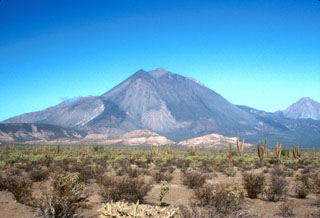 The Tres Vírgenes volcanic complex in central Baja California consists of a NE-SW-trending chain of three volcanoes, seen here from the SE. Volcanism has migrated over time to the SW. El Azufre is the intermediate-age cone to the right and La Vírgen is to the left. The latest major eruption produced a Plinian pumice fall deposit and thick lava flows from a vent near the ridge seen halfway up the SW flank (left).
The Tres Vírgenes volcanic complex in central Baja California consists of a NE-SW-trending chain of three volcanoes, seen here from the SE. Volcanism has migrated over time to the SW. El Azufre is the intermediate-age cone to the right and La Vírgen is to the left. The latest major eruption produced a Plinian pumice fall deposit and thick lava flows from a vent near the ridge seen halfway up the SW flank (left).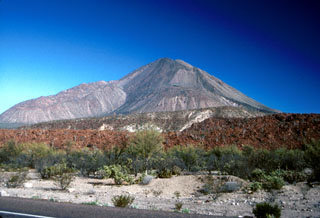 Las Tres Vírgenes is viewed here from the SSE along State Highway 1. The steep-sided Pinto dacite coulée dome is the notable feature on the SW flank (left). Directly in the center, on the S flank, are the Virgen dacite lava domes. The lava flows across the bottom of the photo are part of the Miocene Esperanza Basalt.
Las Tres Vírgenes is viewed here from the SSE along State Highway 1. The steep-sided Pinto dacite coulée dome is the notable feature on the SW flank (left). Directly in the center, on the S flank, are the Virgen dacite lava domes. The lava flows across the bottom of the photo are part of the Miocene Esperanza Basalt.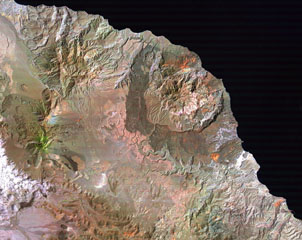 Three major Quaternary volcanic complexes are visible in this Landsat satellite image of Baja California. The N-S-trending Las Vírgenes volcanic complex to the left consists of three stratovolcanoes that are progressively younger towards the south. The 10-km-wide La Reforma caldera along the Gulf of California coast to the right displays darker andesite flanks and a resurgent dome in the center. The extensively eroded El Aguajito caldera has indistinct margins but the large resurgent dome forms the roughly circular eroded hills west of La Reforma.
Three major Quaternary volcanic complexes are visible in this Landsat satellite image of Baja California. The N-S-trending Las Vírgenes volcanic complex to the left consists of three stratovolcanoes that are progressively younger towards the south. The 10-km-wide La Reforma caldera along the Gulf of California coast to the right displays darker andesite flanks and a resurgent dome in the center. The extensively eroded El Aguajito caldera has indistinct margins but the large resurgent dome forms the roughly circular eroded hills west of La Reforma.Maps are not currently available due to technical issues.
There are no samples for Tres Vírgenes in the Smithsonian's NMNH Department of Mineral Sciences Rock and Ore collection.
| Copernicus Browser | The Copernicus Browser replaced the Sentinel Hub Playground browser in 2023, to provide access to Earth observation archives from the Copernicus Data Space Ecosystem, the main distribution platform for data from the EU Copernicus missions. |
|
WOVOdat
Single Volcano View Temporal Evolution of Unrest Side by Side Volcanoes |
WOVOdat is a database of volcanic unrest; instrumentally and visually recorded changes in seismicity, ground deformation, gas emission, and other parameters from their normal baselines. It is sponsored by the World Organization of Volcano Observatories (WOVO) and presently hosted at the Earth Observatory of Singapore.
GVMID Data on Volcano Monitoring Infrastructure The Global Volcano Monitoring Infrastructure Database GVMID, is aimed at documenting and improving capabilities of volcano monitoring from the ground and space. GVMID should provide a snapshot and baseline view of the techniques and instrumentation that are in place at various volcanoes, which can be use by volcano observatories as reference to setup new monitoring system or improving networks at a specific volcano. These data will allow identification of what monitoring gaps exist, which can be then targeted by remote sensing infrastructure and future instrument deployments. |
| IRIS seismic stations/networks | Incorporated Research Institutions for Seismology (IRIS) Data Services map showing the location of seismic stations from all available networks (permanent or temporary) within a radius of 0.18° (about 20 km at mid-latitudes) from the given location of Tres Vírgenes. Users can customize a variety of filters and options in the left panel. Note that if there are no stations are known the map will default to show the entire world with a "No data matched request" error notice. |
| UNAVCO GPS/GNSS stations | Geodetic Data Services map from UNAVCO showing the location of GPS/GNSS stations from all available networks (permanent or temporary) within a radius of 20 km from the given location of Tres Vírgenes. Users can customize the data search based on station or network names, location, and time window. Requires Adobe Flash Player. |
| Large Eruptions of Tres Vírgenes | Information about large Quaternary eruptions (VEI >= 4) is cataloged in the Large Magnitude Explosive Volcanic Eruptions (LaMEVE) database of the Volcano Global Risk Identification and Analysis Project (VOGRIPA). |
| EarthChem | EarthChem develops and maintains databases, software, and services that support the preservation, discovery, access and analysis of geochemical data, and facilitate their integration with the broad array of other available earth science parameters. EarthChem is operated by a joint team of disciplinary scientists, data scientists, data managers and information technology developers who are part of the NSF-funded data facility Integrated Earth Data Applications (IEDA). IEDA is a collaborative effort of EarthChem and the Marine Geoscience Data System (MGDS). |